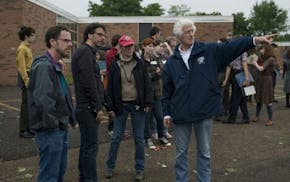The assassination of President John F. Kennedy in Dallas has spawned a cottage industry of books, audio recordings and films devoted to the theory that Lee Harvey Oswald did not act alone but was a pawn in a sprawling, clandestine conspiracy. The era's politics reek of paranoia, to riff off the title of Richard Hofstadter's famous book. Communist spooks, hired guns, right-wing shock jocks: All are as American as Mom's tuna casserole.
In "The Shape of the Ruins" — a layered, meticulously observed new novel, rendered in a sumptuous translation by Anne McLean — Juan Gabriel Vásquez probes two political killings that have molded Colombia, linking them to JFK's murder.
In the fall of 1914, as war scorched Europe in the wake of another assassination, a prominent Bogotá politician, Gen. Raphael Uribe Uribe, was hacked to death by a pair of thugs. This crisis was echoed three decades later when rising Liberal star Jorge Gaitán was gunned down outside a nearby restaurant, sparking the "Violencia," decades of governmental clampdown and rampant bloodshed. In both slayings the government pushed a "lone wolf" (or wolves) hypothesis, but were larger forces at work? And were the events connected?
Against this backdrop Vásquez structures his tale as a weave of fiction and nonfiction. His protagonist, also named Juan Gabriel Vásquez, returns to Bogatá in 2005 from years abroad in Barcelona. At a party he encounters a bizarre, monk-like figure, Carlos Caballo, whose meddlesome questions provoke Vásquez to punch him. That punch lands Vásquez in a mystery that unfolds like a series of Russian nesting dolls. Years later, he's drawn into Caballo's burning need to prove just what happened to Uribe Uribe and Gaitán.
Vásquez's pacing is leisurely, but a story-within-a-story emerges: the brave, brilliant quest of Anzola, a young man enlisted by the Uribe family to investigate the general's assassination. Anzola is indefatigable in his pursuit of truth, even driven to the brink of madness. The parallels between Caballo and Anzola are explicit, as Vásquez unveils a hidden web of policeman and politicos — with a corrupt Catholic church tugging the strings — that have soaked Colombia in blood for generations.
Dense and allusive, with a broad cast of characters, "The Shape of the Ruins" may tax the patience of American readers. It occasionally comes across as an obscure lecture on Colombian history rather than a deep dive into a country's damaged soul. Vásquez seems to acknowledge the reader's dilemma when, Hamlet-like, he cradles Uribe Uribe's cranium, a startling discovery: "Sitting in that room with daylight beginning to creep in through the window, holding in my timid hands the remains of Uribe Uribe's skull, I felt that life had led me to this moment along paths impossible to trace; but I felt, at the same time, that something was escaping me, like someone standing too close to a painting to see clearly what's happening in it."
But stick with it. "The Shape of the Ruins" is far more than a tutorial; it's a gripping Deep State novel that richly illuminates how the powerful brutalize the powerless. Its implications should serve as a cautionary tale for other nations under authoritarian threats. Vásquez has written the epic of his people.
Hamilton Cain is the author of "This Boy's Faith: Notes From a Southern Baptist Upbringing," and a member of the National Book Critics Circle. He lives in Brooklyn.
The Shape of the Ruins
By: Juan Gabriel Vasquez, translated from the Spanish by Anne McLean.
Publisher: Riverhead, 509 pages, $27.

This reporter didn't survive his audition for 'Survivor'
Spring's hot gift book features gorgeous found-nature photos

Jane Smiley hits again with 'Lucky' but what the what is that ending?

Biography details what 'Rulebreaker' Barbara Walters did to get to the top

